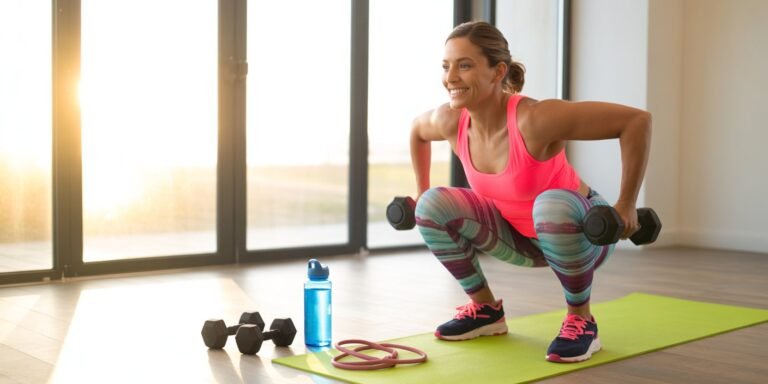If you want stronger, more defined arms, you don’t need a full gym setup or complicated machines — a simple pair of dumbbells can do the job. Whether your goal is toned triceps, fuller biceps, or overall upper-body strength, dumbbell arm workouts are one of the most effective (and versatile) ways to train.
They’re easy to adapt for beginners or advanced lifters, and you can do them almost anywhere — at home, in the gym, or even outside.
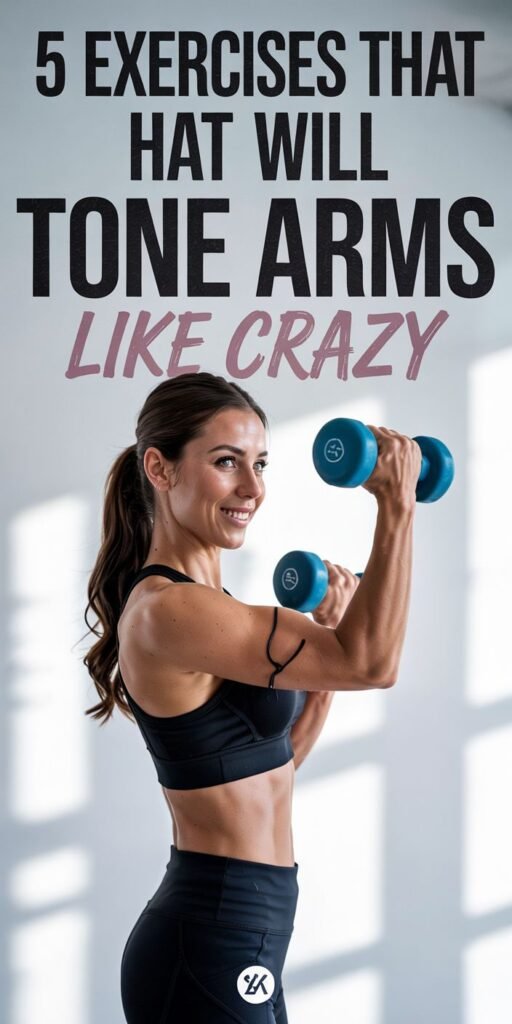
In this guide, we’ll break down the best dumbbell exercises to target every major arm muscle, explain how to perform them correctly, and show you how to structure a routine that actually gets results.
Say goodbye to “flabby arms” myths and endless cardio — these moves are all about building lean muscle, boosting strength, and creating arms you’ll feel confident showing off.
In this guide, you’ll learn:
- The best dumbbell arm exercises for muscle growth and toning.
- A step-by-step workout routine for beginners and advanced lifters.
- Benefits of dumbbell arm workouts and how they help with strength and endurance.
Let’s get started!
Just a heads up: This post contains affiliate links, which means we may earn a small commission if you buy through them — at no extra cost to you. We only recommend dumbbells, gear, and tools we trust to help you tone up, build strength, and level up your arm workouts.
Benefits of Dumbbell Arm Workouts
Dumbbell arm workouts are one of the most effective ways to develop strength and lean muscle.
Because each arm lifts weight independently, your muscles are constantly working against resistance, which stimulates growth.
Over time, this not only builds bigger biceps and stronger triceps but also improves your overall pushing and pulling strength.
Unlike machines that lock you into fixed motions, dumbbells allow your muscles to move naturally, which makes them work harder and adapt faster.
Improve Muscle Balance and Symmetry
When using a barbell or machine, the stronger side of your body often compensates for the weaker side.
With dumbbells, each arm is responsible for carrying its own load, preventing dominance from one side.
This helps correct imbalances, strengthens weaker muscles, and creates a more symmetrical appearance.
Balanced arms not only look better but also reduce the risk of long-term injuries caused by uneven strength distribution.
Increase Range of Motion and Flexibility
One of the biggest advantages of dumbbells is the freedom they provide.
Unlike fixed equipment, dumbbells let your arms move in a natural path, which increases your range of motion.
This means muscles are stretched and contracted more fully, leading to better flexibility and improved joint mobility.
For example, a dumbbell curl allows you to rotate your wrists and move your elbows freely, reducing strain while targeting the muscles more effectively.
Boost Calorie Burn and Fat Loss
Dumbbell arm workouts do more than build muscle — they also help burn calories.
The more muscle mass you build, the higher your metabolism becomes, which means your body burns more energy even at rest.
Incorporating dumbbell arm moves into circuit training or combining them with compound lifts like presses and rows raises your heart rate, turning strength training into a calorie-burning workout that supports fat loss and toning.
Support Joint Health and Stability
Unlike machines that often isolate only large muscle groups, dumbbells engage stabilizing muscles around your shoulders, elbows, and wrists.
This builds joint strength and stability, making your arms more resilient to injuries.
Stronger stabilizer muscles help reduce wear and tear, improve control during movements, and allow you to perform daily tasks with less strain on your joints.
Versatility and Convenience
Dumbbells are highly versatile and can be used anywhere, whether at home, outdoors, or in the gym.
You can perform dozens of exercises with just one pair, from bicep curls to overhead presses and tricep kickbacks.
They also work for all fitness levels, since you can easily adjust the weight based on your progress.
Their compact size makes them easy to store, giving you maximum training options without needing bulky equipment.
Improve Athletic Performance and Daily Strength
Stronger arms do more than improve appearance. Dumbbell training translates directly into better performance in sports and daily life.
Carrying groceries, lifting boxes, throwing, and pushing all become easier as your arms adapt to resistance training.
Athletes also benefit from dumbbell workouts because they mimic natural movement patterns, training multiple muscle groups at once for improved functional strength.
Best Dumbbell Arm Exercises
Here are the top exercises to target your biceps, triceps, shoulders, and forearms.
1️⃣ Bicep Curls (Targets: Biceps)
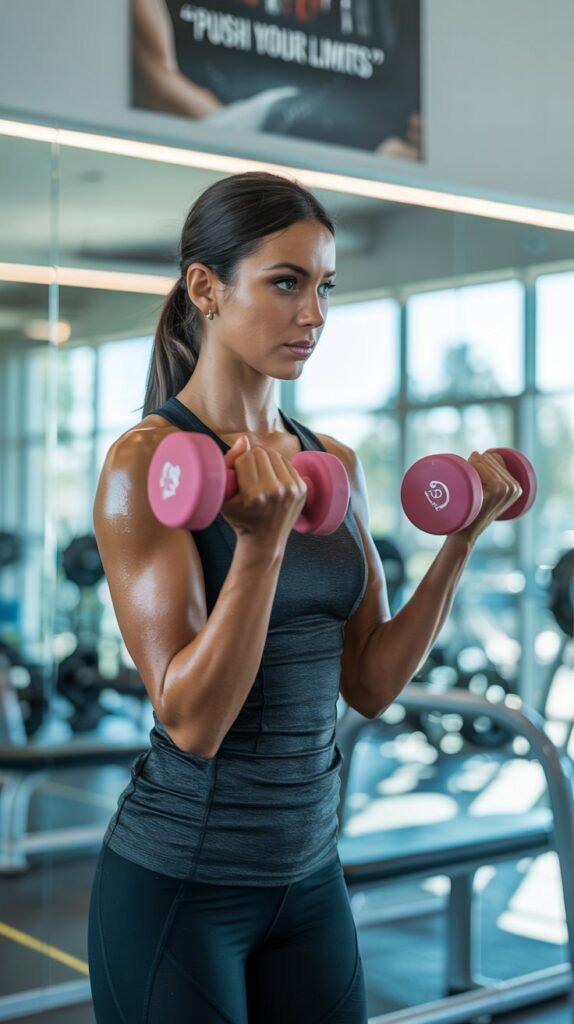
Bicep curls are one of the most fundamental dumbbell arm exercises, designed specifically to strengthen and shape the front of your upper arm.
This move isolates the biceps, helping you build size, definition, and pulling strength that transfers into everyday tasks and sports performance.
How to Do It
- Start Position: Stand tall with your feet shoulder-width apart, holding a dumbbell in each hand. Let your arms hang at your sides with palms facing forward.
- Engage Core: Keep your elbows close to your torso and brace your core for stability.
- Curl the Weight: Slowly bend your elbows to lift the dumbbells toward your shoulders. Focus on squeezing the biceps at the top of the movement.
- Lower with Control: Gradually lower the dumbbells back to the starting position. Avoid swinging or using momentum.
- Repeat: Perform 10–15 reps for 2–3 sets, adjusting the weight to match your fitness level.
✅ Pro Tip: Avoid moving your shoulders or leaning backward — only your forearms should move. For variation, try hammer curls (palms facing each other) to target the brachialis and forearms.
👉 “From beginner to pro — BodySport Dumbbells grow with you. Get the versatility you need for strength training without breaking the bank.”
2️⃣ Hammer Curls (Targets: Biceps & Forearms)
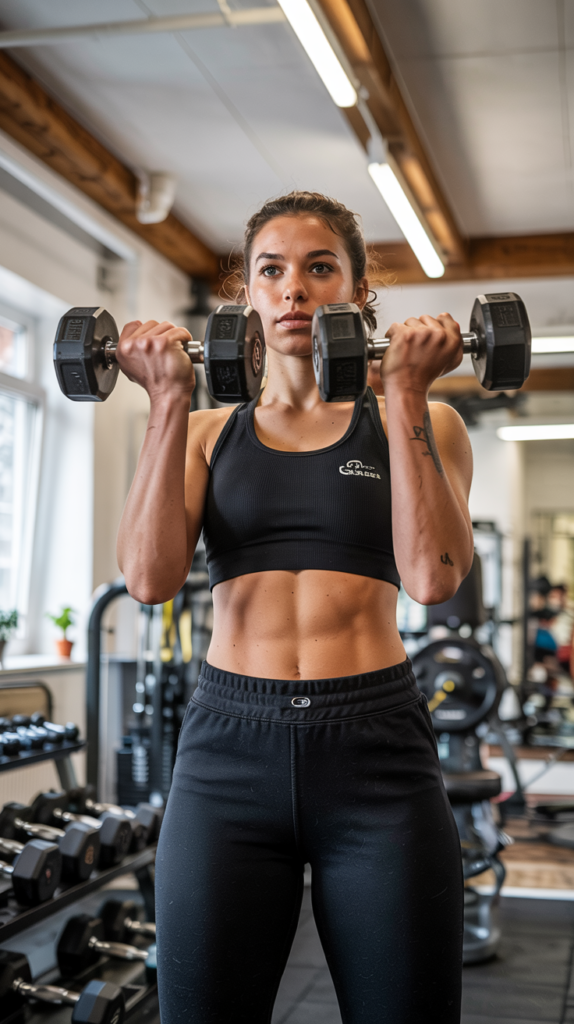
Hammer curls are a powerful variation of the traditional bicep curl that not only strengthen the biceps but also heavily engage the forearms and brachialis — a muscle that lies beneath the biceps.
Building the brachialis helps add width and thickness to the upper arm, giving your arms a more complete and balanced look.
Hammer curls are also excellent for grip strength, which improves performance in other lifts and everyday activities like carrying groceries or lifting heavy objects.
How to Do It
- Start Position: Stand tall with a dumbbell in each hand, arms fully extended by your sides, and palms facing inward toward each other (neutral grip).
- Engage Core: Keep your elbows tucked close to your torso and brace your abs for stability.
- Curl the Dumbbells: Slowly bend your elbows to lift both dumbbells upward toward your shoulders, maintaining the neutral grip throughout the movement.
- Squeeze at the Top: Pause briefly at the top of the curl, focusing on squeezing your biceps and forearms.
- Lower with Control: Slowly return the dumbbells back to the starting position.
- Repeat: Perform 10–12 reps for 2–3 sets.
Pro Tip: Don’t swing the weights or lean backward. For added intensity, try alternating curls (lifting one arm at a time) or slow negatives (taking 3–4 seconds to lower the dumbbell).
3️⃣ Overhead Triceps Extension (Targets: Triceps)
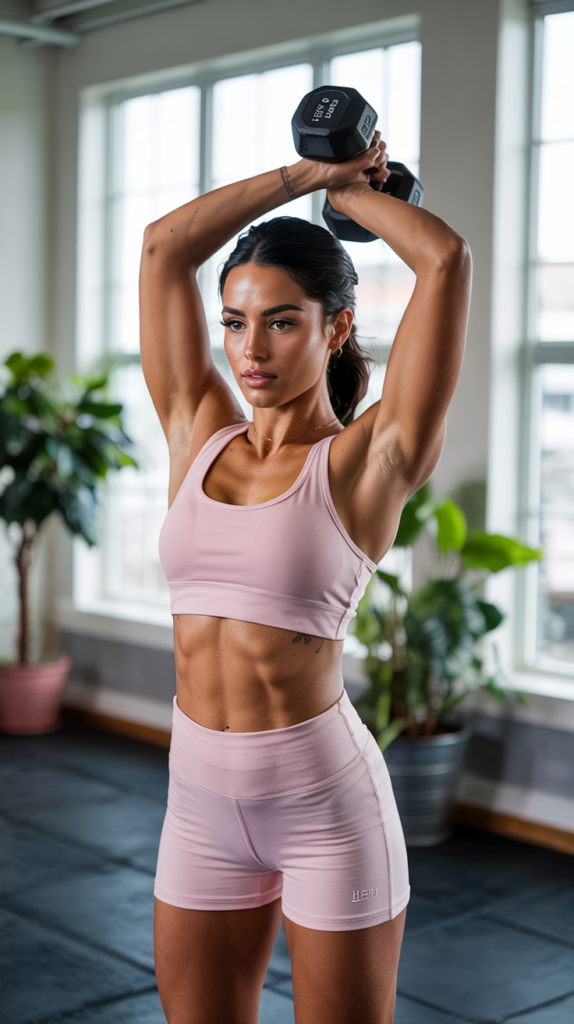
The overhead triceps extension is one of the most effective dumbbell exercises for isolating and strengthening the triceps — the large muscles at the back of your upper arms.
Strong triceps not only improve arm definition but also support pressing movements like push-ups, bench presses, and overhead lifts.
This exercise emphasizes the long head of the triceps, helping you build fuller and more sculpted arms.
How to Do It
- Start Position: Hold one dumbbell with both hands (palms under the top plate) and raise it overhead until your arms are fully extended. Keep your elbows close to your ears and your core engaged.
- Lower the Weight: Slowly bend your elbows to lower the dumbbell behind your head, keeping your upper arms stationary. Only your forearms should move.
- Stretch & Control: Lower the dumbbell until you feel a gentle stretch in the triceps. Avoid letting your elbows flare out too wide.
- Press Back Up: Extend your elbows to lift the dumbbell back overhead, squeezing the triceps at the top.
- Repeat: Perform 10–12 reps for 2–3 sets.
Pro Tip: If using one heavy dumbbell feels awkward, perform the move with a dumbbell in each hand for more control. You can do this exercise seated or standing, but seated reduces the chance of arching your lower back.
When I first started working out at home, I realized I needed a dumbbell that was versatile, easy to use, and actually felt comfortable during exercises.
That’s when I found the [TYZDMY] Dumbbells, and honestly, they’ve been a game-changer for me.
I can adjust the weight for different exercises, the grip feels great in my hands, and they don’t take up much space at all.
I use them for everything—from bicep curls to chest presses to squats—and it just makes my workouts so much more effective.
If you’re looking for a simple way to step up your home workouts, I’d definitely recommend giving these a try.
You can check them out here and see if they fit into your routine as well

4️⃣ Triceps Kickbacks (Targets: Triceps)
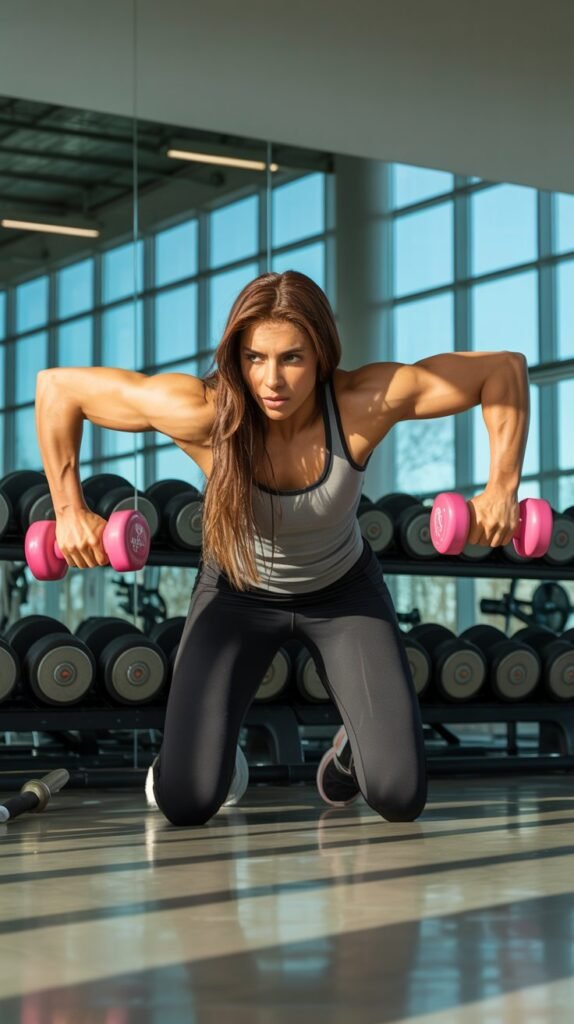
If you’re looking to tighten up the back of your arms and get rid of that “flabby” feeling many people complain about, triceps kickbacks are one of the best moves you can do.
They zero in on your triceps — the muscle that makes up about two-thirds of your upper arm — and help give your arms that toned, defined look.
On top of looks, strong triceps also make everyday pushing movements (like opening doors or pushing a cart) a lot easier and improve your strength in bigger lifts like push-ups and bench presses.
How to Do Triceps Kickbacks
- Grab a pair of light-to-moderate dumbbells. Stand with your feet about hip-width apart and soften your knees.
- Hinge forward at your hips so your torso leans slightly forward — almost parallel to the floor. Keep your back straight and core tight.
- Bend your elbows to about 90 degrees so the dumbbells are hanging down at your sides, palms facing each other. This is your starting point.
- From here, press the dumbbells straight back by extending your elbows. Keep your upper arms locked in close to your sides — only your forearms should move.
- When your arms are fully straight, squeeze your triceps hard for a second or two.
- Slowly bring the dumbbells back to the starting position with control.
- Do 10–15 reps for 2–4 sets.
Tips to Get It Right
- Keep your elbows tucked into your ribs — if they flare out, you’re taking the work off your triceps.
- Move slowly and avoid swinging the weights.
- Pick a weight you can control — too heavy, and your form will fall apart.
- Keep your spine neutral and your core engaged to avoid stressing your lower back.
Mistakes to Watch Out For
- Using momentum: Swinging the dumbbells instead of controlling them takes away the benefit.
- Letting your elbows drop: Your upper arms should stay fixed in place.
- Arching your back: Protect your spine by keeping your abs tight.
Why Triceps Kickbacks Work
- They directly target the back of your arms, helping with muscle tone and definition.
- They strengthen the triceps, which improves push-ups, presses, and daily movements.
- They’re easy to set up — all you need is a pair of dumbbells and a little space.
- They balance out your arm development since the triceps are often overlooked compared to the biceps.
Variations to Try
Pause reps: Hold at the top for 2–3 seconds to really fire up the triceps.
Single-arm kickbacks: Work one side at a time to really focus on muscle engagement.
Incline bench kickbacks: Rest your chest on a bench to take pressure off your lower back.
Resistance band kickbacks: Great option if you don’t have dumbbells — plus bands keep constant tension on the muscle.
👉 “Stop cluttering your space with multiple dumbbells. BodySport Adjustable Dumbbells give you 3–40 lbs in one sleek design. Grab yours now and upgrade your workouts!”
5️⃣ Lateral Raises (Targets: Shoulders)
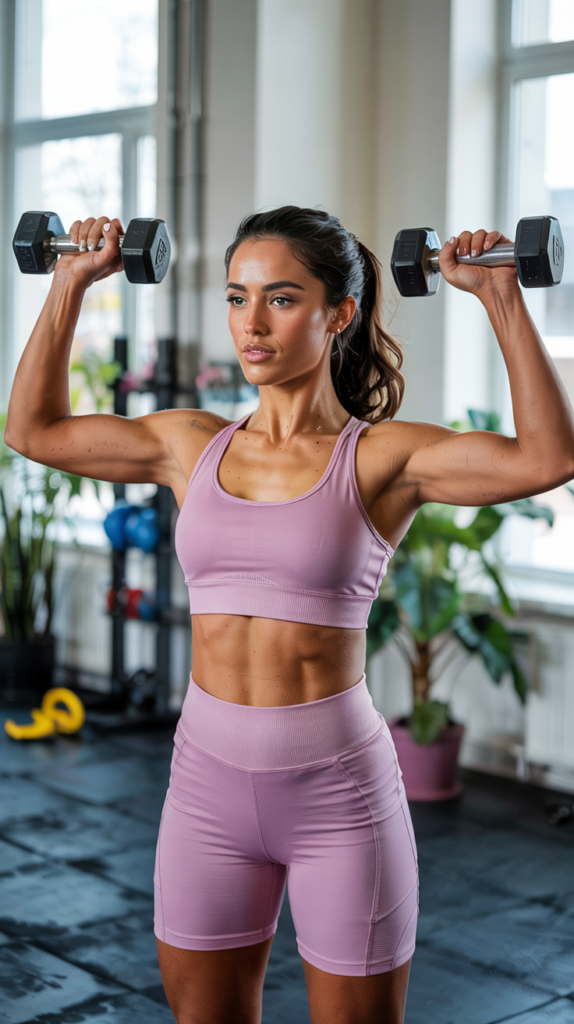
Lateral raises are a go-to move for building strong, sculpted shoulders. This exercise mainly works your lateral deltoids (the middle part of your shoulder muscle), which give your shoulders that wide, rounded look.
When done consistently, lateral raises can make your upper body appear more balanced and athletic.
Plus, strong shoulders don’t just look good — they help with everyday movements like lifting groceries, reaching overhead, or pushing heavy objects.
How to Do Lateral Raises
- Stand tall with your feet hip-width apart and hold a dumbbell in each hand at your sides, palms facing in.
- Keep a slight bend in your elbows — don’t lock them out.
- Brace your core, keep your chest up, and slowly lift both arms out to the sides until they’re at shoulder height. Your body should look like a “T.”
- Pause at the top and squeeze your shoulders.
- Slowly lower the dumbbells back down to your sides with control.
- Repeat for 10–15 reps, aiming for 2–4 sets.
Form Tips
- Don’t swing the weights — the slower you go, the better the muscle activation.
- Keep your wrists neutral (don’t twist them up or down).
- Exhale as you lift, inhale as you lower.
- Think about “lifting with your elbows” instead of your hands — this helps target the shoulders better.
Mistakes to Avoid
- Lifting too high: Going above shoulder level puts extra stress on your neck and traps instead of your delts.
- Using momentum: Jerking the weights up makes the exercise less effective.
- Going too heavy: This exercise works best with lighter weights so you can focus on form.
Why Lateral Raises Work
- Build wider shoulders and improve upper body shape.
- Strengthen the muscles that stabilize your shoulders, which can reduce the risk of injury.
- Improve pressing strength for exercises like bench press and overhead press.
- Enhance everyday movement strength, like lifting objects to the side or overhead.
Variations to Try
- Seated Lateral Raises: Sitting down reduces momentum and forces your shoulders to work harder.
- Single-Arm Lateral Raise: Focus on one shoulder at a time for better control.
- Front-to-Lateral Raise Combo: Alternate between lifting dumbbells forward and to the side for full shoulder activation.
- Pause or Slow Reps: Hold at the top for 2–3 seconds or use a slower tempo to increase intensity.
Start light — even 5–10 lb dumbbells can feel challenging when done correctly. Focus on control and let your shoulders, not your ego, do the lifting.
6️⃣ Dumbbell Shoulder Press (Targets: Shoulders & Triceps)
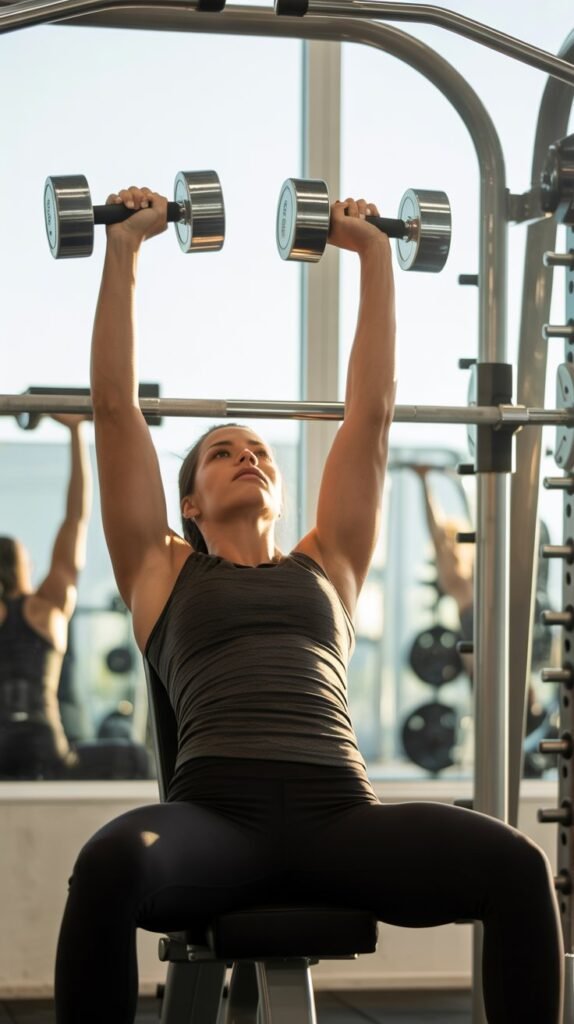
The dumbbell shoulder press is one of the best moves for building strength and size in your shoulders while also engaging your triceps.
It mimics everyday pushing movements — like lifting boxes overhead or putting groceries on a top shelf — making it a functional exercise as well as a muscle-building staple.
Because you’re pressing dumbbells independently, your stabilizer muscles work harder compared to a barbell press, which helps improve balance and correct strength imbalances between arms.
How to Do Dumbbell Shoulder Press
- Sit on a bench with back support (or stand tall with your feet shoulder-width apart).
- Hold a dumbbell in each hand at shoulder height with your palms facing forward and elbows bent at 90 degrees.
- Brace your core and keep your chest lifted.
- Press both dumbbells straight up until your arms are fully extended overhead without locking your elbows.
- Slowly lower the weights back to shoulder level under control.
- Repeat for 8–12 reps, performing 2–4 sets.
Form Tips
- Keep your back flat against the bench (or avoid leaning back if standing).
- Don’t flare your elbows too wide — keep them slightly in front of your body to protect your shoulders.
- Move with control, especially on the lowering phase (eccentric), to maximize strength and safety.
- Exhale as you press up, inhale as you lower down.
Mistakes to Avoid
- Using momentum: Don’t arch your back or push with your legs if you’re doing the strict version.
- Locking out elbows: Snapping your joints puts unnecessary strain on them.
- Going too heavy too soon: Focus on proper range of motion before increasing weight.
Why the Dumbbell Shoulder Press Works
- Builds overall shoulder strength and size, targeting the anterior and medial deltoids.
- Engages your triceps, helping you push heavier weights in other upper-body moves.
- Improves stability and balance since each arm works independently.
- Boosts functional strength for daily overhead movements.
Variations to Try
- Seated Shoulder Press: Offers more stability and lets you lift heavier.
- Standing Shoulder Press: Engages your core more for balance.
- Arnold Press: Rotate your palms inward as you lower and outward as you press up for full shoulder activation.
- Single-Arm Press: Helps fix imbalances and improves core stability.
If you’re new, start light (8–15 lb dumbbells) and focus on form. Over time, gradually increase the weight to keep building strength and definition.
7️⃣ Reverse Curls (Targets: Forearms & Biceps)
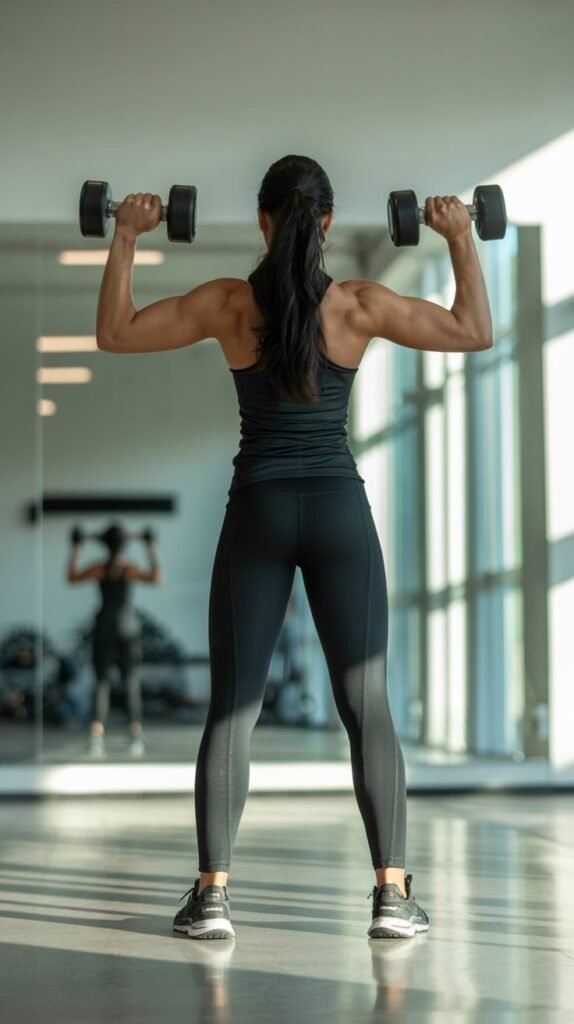
Reverse curls are a fantastic exercise for building stronger forearms and thicker, more balanced biceps.
Unlike traditional curls, which focus mainly on the biceps, reverse curls shift more of the workload to your brachialis (a muscle beneath the biceps) and brachioradialis (the big muscle running down the forearm).
Strengthening these muscles not only improves grip strength but also helps your arms look fuller and more defined from every angle.
How to Do Reverse Curls
- Stand tall with your feet shoulder-width apart, holding a dumbbell in each hand.
- Grip the dumbbells with your palms facing down (overhand grip).
- Keep your elbows tucked in close to your sides and your shoulders relaxed.
- Slowly curl the dumbbells upward toward your shoulders, keeping your wrists straight and firm (don’t let them bend).
- Squeeze your forearms and biceps at the top of the movement.
- Lower the dumbbells back down under control.
- Perform 10–15 reps for 2–4 sets.
Form Tips
- Keep your wrists locked in a straight line — bending them reduces the focus on your forearms.
- Move slowly to maximize muscle tension and avoid swinging the weights.
- Exhale as you curl up, inhale as you lower down.
Mistakes to Avoid
- Using momentum: Don’t swing the dumbbells — this is an isolation move, so slow and controlled is best.
- Going too heavy: Reverse curls hit smaller muscles that fatigue quickly, so use lighter dumbbells than you would for standard curls.
- Letting elbows drift forward: Keep them tucked to your sides for strict form.
Why Reverse Curls Work
- Strengthens the forearms, improving grip strength for pulling exercises and everyday tasks.
- Builds up the brachialis, which makes your arms look thicker and more powerful.
- Helps balance out bicep development, reducing risk of overuse injuries.
- Improves performance in sports and lifts that require a strong grip.
Variations to Try
- Barbell or EZ Bar Reverse Curls: Allows heavier weight but still targets the same muscles.
- Single-Arm Dumbbell Reverse Curl: Focuses on one arm at a time to fix imbalances.
- Slow Negatives: Lower the weight very slowly to increase forearm burn and strength.
Start light — even 5–12 lb dumbbells are plenty for beginners. Focus on form and control, and you’ll feel your forearms fire up right away.
Turn your home into a full gym with BodySport Adjustable Dumbbells — one set replaces 12 weights. Save space, build strength, and train smarter today!”
8️⃣ Wrist Curls (Targets: Forearms)
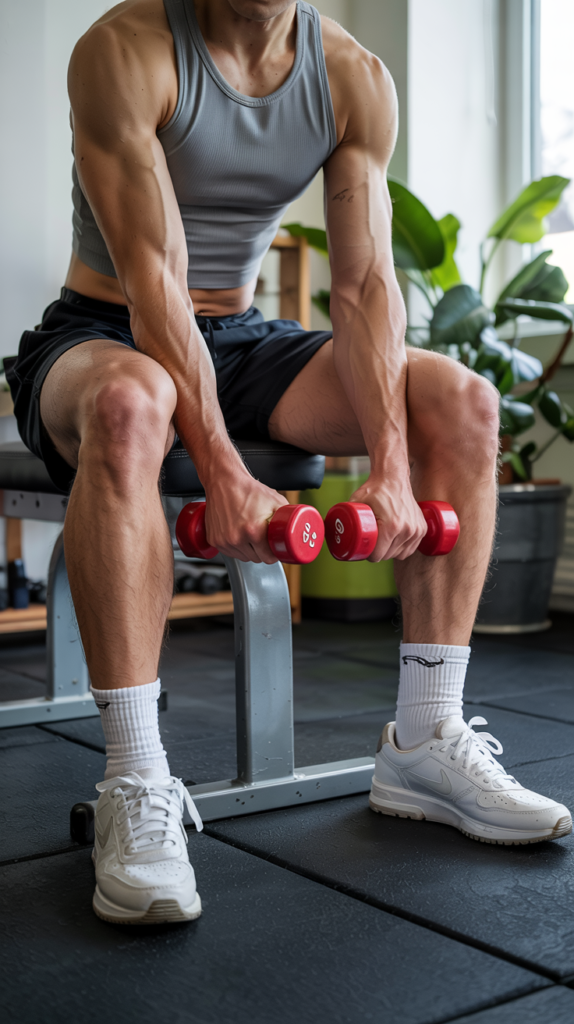
Wrist curls are one of the simplest but most effective exercises for strengthening and developing your forearm flexor muscles — the ones responsible for bending your wrist and gripping objects.
Strong forearms not only improve grip strength for lifts like deadlifts, pull-ups, and rows, but they also make everyday tasks (like carrying grocery bags or opening jars) much easier.
Aesthetically, forearm training helps complete the look of well-built arms, giving them more size and definition.
How to Do Wrist Curls
- Sit on a bench or chair with a dumbbell in each hand.
- Rest your forearms on your thighs so your wrists extend just past your knees, palms facing up toward the ceiling.
- Let the dumbbells roll down to your fingers to stretch your forearms.
- Curl the dumbbells upward by flexing your wrists, bringing them as high as possible.
- Squeeze at the top for 1–2 seconds.
- Slowly lower the dumbbells back to the starting position.
- Perform 12–20 reps for 2–4 sets.
Form Tips
- Keep your forearms firmly planted on your thighs — only your wrists should move.
- Use a slow, controlled motion, especially on the lowering phase.
- Don’t grip the dumbbells too tightly; let them roll into your fingers at the bottom for a full stretch.
- Exhale as you curl up, inhale as you lower down.
Mistakes to Avoid
- Using too much weight: Your forearm flexors are smaller muscles, so start light to avoid strain.
- Rushing the reps: Fast reps reduce tension and limit growth — slow and steady is key.
- Lifting your forearms: Keep them anchored for maximum isolation.
Why Wrist Curls Work
- Build forearm size and strength for a complete arm look.
- Improve grip endurance for strength training and sports.
- Reduce the risk of wrist and elbow injuries by strengthening supporting muscles.
- Enhance performance in pulling and curling exercises by boosting grip stability.
Variations to Try
- Reverse Wrist Curls (Palms Down): Targets the forearm extensors on the top side of your forearm.
- Single-Arm Wrist Curl: Focuses on one wrist at a time for better control and balance.
- Behind-the-Back Wrist Curls: Stand with dumbbells behind you, palms facing backward, and curl up — this adds a new angle to challenge your forearms.
For best results, train forearms 1–2 times per week at the end of your workout. Even light dumbbells (5–15 lbs) will give you a serious burn if you perform wrist curls slowly and with control.
Dumbbell Arm Workout Routine
Here’s a structured workout plan for beginners and advanced lifters.
Beginner Dumbbell Arm Workout (3 Days a Week)
If you’re just starting out, this 3-day dumbbell arm workout is perfect for building strength, toning your arms, and learning proper form.
It uses simple but effective moves for your biceps, triceps, and shoulders — and since it only requires dumbbells, you can do it at home or in the gym.
Stick with it consistently, and you’ll notice stronger, more defined arms in just a few weeks.
Workout Plan Overview
- Frequency: 3 days per week (e.g., Monday, Wednesday, Friday)
- Equipment: Pair of light to medium dumbbells (5–15 lbs for beginners)
- Sets & Reps: 2–3 sets of 10–15 reps per exercise
- Rest: 45–60 seconds between sets
Day 1 – Push & Press (Triceps & Shoulders Focus)
- Dumbbell Shoulder Press – 3×10–12
- Overhead Triceps Extension – 3×12–15
- Lateral Raises – 2×12–15
- Triceps Kickbacks – 3×12–15
This day strengthens your pushing muscles while building round shoulders and toned triceps.
Day 2 – Pull & Curl (Biceps & Forearms Focus)
- Bicep Curls – 3×10–12
- Hammer Curls – 3×12–15
- Reverse Curls – 2×12–15
- Wrist Curls – 2×15–20
This day targets your pulling muscles, giving you fuller biceps and stronger forearms.
Day 3 – Full Arm Circuit (Balanced Focus)
- Dumbbell Shoulder Press – 3×10–12
- Bicep Curls – 3×12–15
- Triceps Kickbacks – 3×12–15
- Lateral Raises – 2×12–15
- Hammer Curls – 2×12–15
This balanced session hits all areas of your arms in one workout, improving endurance and definition.
Beginner Tips
- Start with light dumbbells to nail your form before increasing weight.
- Focus on slow, controlled reps — don’t rush through the movements.
- Train on non-consecutive days (e.g., Mon/Wed/Fri) to allow your muscles to recover.
- Combine this plan with a balanced diet and regular cardio for the best results.
With consistency, this beginner-friendly dumbbell arm workout will help you build a solid foundation of strength, tone your arms, and prepare you for more advanced training later.
Advanced Dumbbell Arm Workout (4-5 Days a Week)
If you’ve been training for a while and want to push past plateaus, this advanced dumbbell arm workout is designed for serious strength and size gains.
Unlike beginner routines, this program uses higher volume, more intensity techniques, and advanced variations to challenge your muscles from every angle.
By training 4–5 days a week, you’ll give your arms plenty of focused work while still balancing recovery.
Workout Plan Overview
- Frequency: 4–5 days per week (split style: push, pull, shoulders/arms, full arm pump)
- Equipment: Dumbbells (light, medium, and heavy sets) + optional bench
- Sets & Reps: 3–5 sets of 8–15 reps (lower reps with heavier weight, higher reps with lighter weight)
- Rest: 45–75 seconds between sets, depending on exercise intensity
Day 1 – Heavy Push (Triceps & Shoulders Power)
- Seated Dumbbell Shoulder Press – 4×8–10 (go heavy, focus on strength)
- Overhead Dumbbell Triceps Extension – 4×10–12
- Arnold Press – 3×10–12
- Close-Grip Dumbbell Press – 3×8–10
- Lateral Raises with Drop Set – 3×12–15 + drop weight and continue to failure
This day emphasizes pressing strength and triceps mass with heavy dumbbell movements.
Day 2 – Heavy Pull (Biceps & Forearms Strength)
- Alternating Bicep Curls (Heavy) – 4×8–10
- Hammer Curls – 4×10–12
- Incline Dumbbell Curls – 3×10–12 (deep stretch on biceps)
- Reverse Curls – 3×12–15
- Wrist Curls & Reverse Wrist Curls Superset – 3×15–20 each
Focus on heavy curls for size and strength, plus direct forearm training for grip power.
Day 3 – Shoulder & Arm Shaper (Definition & Volume)
- Arnold Press – 4×12
- Lateral Raises (Pause at Top) – 4×12–15
- Concentration Curls – 3×12–15
- Zottman Curls – 3×12–15 (curl up palms up, lower palms down)
- Overhead Triceps Kickbacks (Single Arm) – 3×12–15
- Front Raises (Light & Slow) – 3×15–20
This day uses moderate weights and higher reps to carve out definition and shape.
Day 4 – Full Arm Pump (Hypertrophy Focus)
- Dumbbell Shoulder Press – 3×10–12
- Superset: Bicep Curls + Triceps Kickbacks – 3×12 each
- Incline Dumbbell Curl (Slow Negatives) – 3×8–10
- Overhead Dumbbell Triceps Extension (Single Dumbbell, Both Hands) – 3×12–15
- 21s Bicep Curl Method – 3 sets (7 half reps low, 7 half reps high, 7 full reps)
This workout maximizes blood flow and muscle pump, perfect for growth and finishing the week strong.
Day 5 (Optional) – Weak Point Training / Extra Volume
- Pick 2–3 exercises for the muscle group you want to improve most (e.g., lateral raises for wider shoulders, hammer curls for forearms, triceps extensions for back of the arms).
- Perform 3–4 sets of 12–20 reps per exercise with moderate weight.
Advanced Training Tips
- Use progressive overload: increase weight or reps weekly to force growth.
- Incorporate drop sets, supersets, and slow negatives for intensity.
- Prioritize form over ego lifting — advanced doesn’t mean sloppy.
- Nutrition and recovery are crucial at this stage — fuel with enough protein and allow muscles to rest.
This advanced dumbbell arm program is built to maximize size, strength, and definition.
If you stay consistent, you’ll notice not only bigger arms but also stronger lifts and improved performance in other workouts.
FAQs About Dumbbell Arm Workouts
1. How often should I train my arms with dumbbells?
Most people see great results training arms 2–3 times per week. Beginners can start with two sessions while advanced lifters can handle more frequent training if they manage recovery properly. Your arms also get worked indirectly during chest, back, and shoulder workouts, so balance is key.
2. How heavy should my dumbbells be?
Choose a weight that feels challenging but still allows you to perform each rep with good form. A good rule: if you can’t complete 8 reps with proper technique, the dumbbell is too heavy. If you can easily perform more than 15 reps, it’s probably too light. Adjust as you get stronger.
3. Can I build big arms with just dumbbells?
Yes! Dumbbells are excellent for both strength and muscle growth. With proper progression, consistent training, and the right nutrition, you can build size and definition in your biceps, triceps, shoulders, and forearms using only dumbbells.
4. Should I do dumbbell arm workouts before or after other exercises?
That depends on your goals. If building bigger arms is your priority, train them earlier in your session when you have the most energy. If overall strength or performance in compound lifts (like bench press or pull-ups) matters more, save arms for after your main lifts.
5. How long does it take to see results?
Most people notice strength improvements within 2–4 weeks and visible muscle definition in 8–12 weeks, depending on consistency, diet, and overall workout plan. Progress varies, but steady training always pays off.
6. Do I need different dumbbell sizes?
Yes. Your biceps may need lighter weights for strict curls, while your shoulders or triceps can often handle heavier loads. Having at least two or three pairs of dumbbells—or adjustable dumbbells—gives you more flexibility.
7. Can women do dumbbell arm workouts without getting bulky?
Absolutely. Women don’t naturally gain bulky muscle without years of intense training and specific nutrition. Instead, dumbbell arm workouts will help women build lean, toned, and strong arms that enhance definition and athletic ability.
8. Should I combine dumbbell arm workouts with cardio?
Yes. Combining weight training with cardio creates the best balance for overall fitness. Cardio helps with fat loss and endurance, while dumbbell arm workouts build strength and definition. Doing both makes your arms not just stronger but also leaner.
9. What if I don’t feel sore after my dumbbell workout?
Soreness isn’t the only indicator of progress. If you’re lifting with good form, progressively challenging yourself, and improving over time, you’re on the right track—even without soreness. Focus on performance, not just how you feel the next day.
10. Can dumbbell arm workouts help me lose fat in my arms?
Dumbbell training strengthens and tones your arm muscles, but spot reduction isn’t possible. To lose fat in your arms, you’ll need a combination of strength training, cardio, and a calorie-controlled diet. As overall body fat decreases, your arms will naturally look leaner.
Final Thoughts
Dumbbell arm workouts are not just about getting bigger arms—they’re about building balanced strength, improving endurance, and supporting the rest of your fitness journey.
When you commit to training your arms with dumbbells, you’re strengthening the muscles that help with everyday movements like carrying groceries, pushing doors, lifting boxes, or even holding good posture while you sit and stand.
Strong arms also support other compound lifts such as bench presses, pull-ups, and rows, making you a more well-rounded lifter overall.
For beginners, dumbbells are a safe and simple starting point because you can control the movement more easily than with barbells or heavy gym machines.
Learning proper form now sets you up for long-term success and prevents injury. As you progress, you can steadily increase the weight, volume, and intensity to keep challenging your muscles.
For advanced lifters, dumbbells offer versatility—you can isolate weak points, push past plateaus, and build symmetrical strength by working each arm independently.
It’s also important to remember that results don’t come overnight. Muscle growth and toning happen gradually with consistent effort, smart programming, and proper recovery.
Pair your workouts with good nutrition—plenty of protein to rebuild muscle fibers, healthy carbs to fuel your sessions, and enough rest days so your body can recover and grow stronger.
Sleep plays a huge role in recovery too, so make sure you’re not skipping that part of the process.
At the end of the day, dumbbell arm workouts are accessible, effective, and adaptable.
Whether you’re training at home or in the gym, a pair of dumbbells can help you build stronger, more defined arms, improve athletic performance, and boost your overall confidence.
Stay consistent, challenge yourself with progressive overload, and track your progress week after week. With time and dedication, you’ll notice not only physical changes but also an increase in your strength, energy, and self-discipline.




